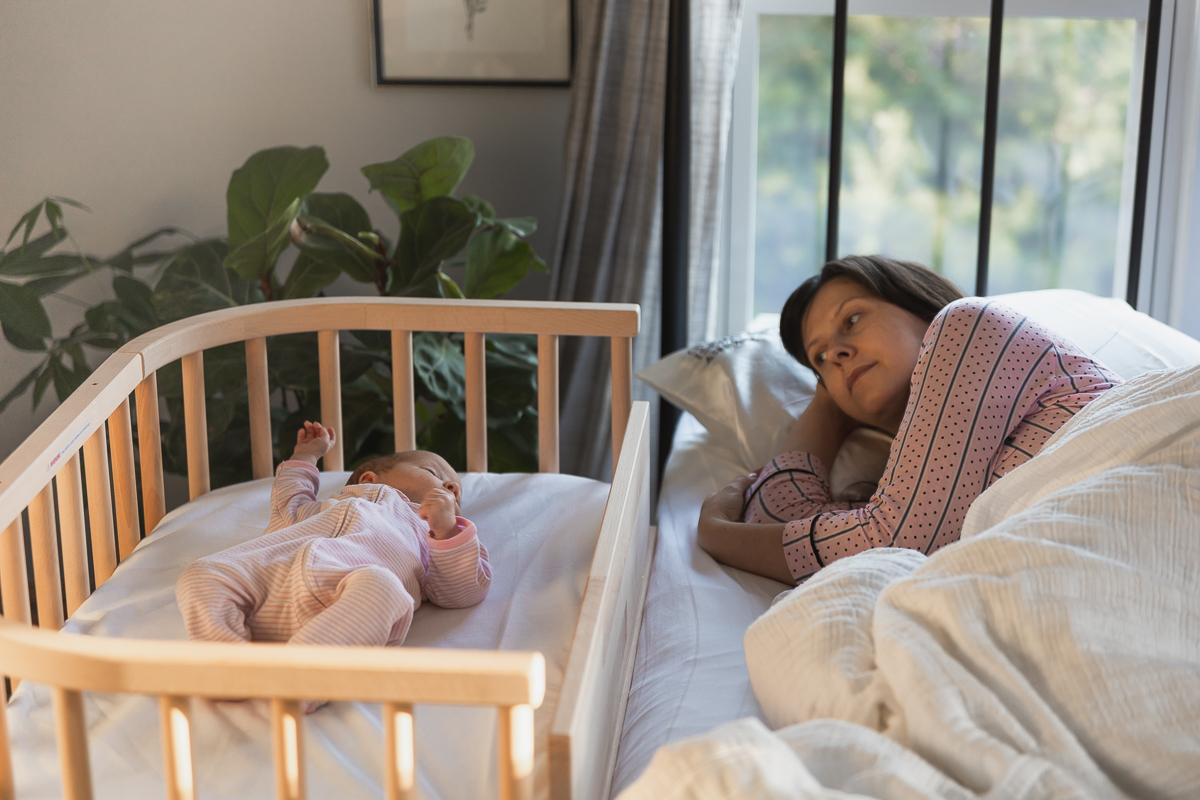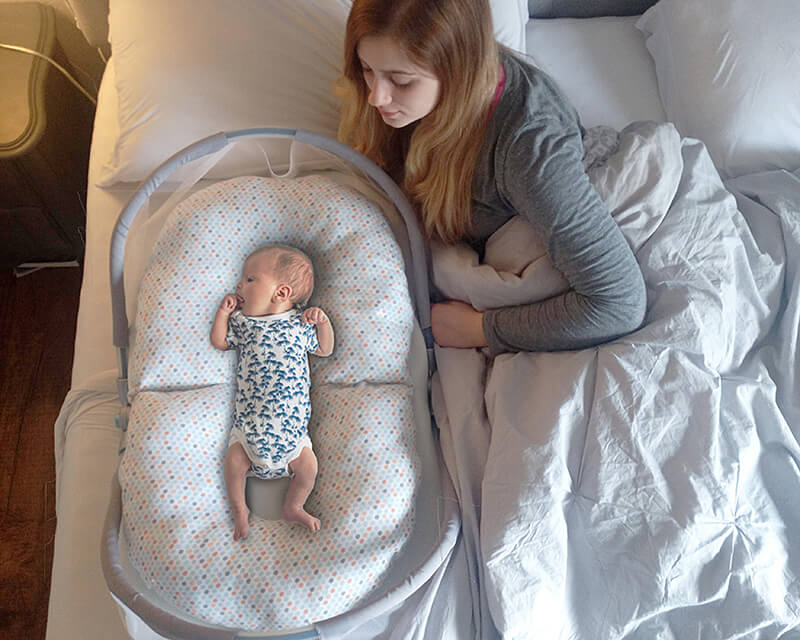How Old Infant in Bed Co Sleeper?
The age of an infant in a bed co sleeper can vary depending on the product and manufacturer. Generally, most bed co sleepers are meant for infants up to 6 months old or until they begin to roll over. Some models may accommodate babies up to one year old or even more but it is best to follow the guidelines provided by the product’s manufacturer for exact information about your specific model.
It is also important that parents use common sense when deciding whether their baby is ready for a bedside sleeper as some babies may not be developmentally ready at any given age.
When it comes to sleeping arrangements for infants, bed co-sleepers are a popular option. Bed co-sleepers provide parents with the convenience of having their infant sleep close at hand while still providing them with their own safe space in which to sleep. Typically, infants should not be placed in bed co-sleepers until they have reached 3 months of age; this allows time for the baby’s neck muscles to strengthen and helps ensure that he or she is developmentally ready for sleeping without support from their parent’s arms.
Is It Safe to Co Sleep With a 1 Year Old
Yes, it is generally safe to co-sleep with a 1 year old; however, it is important to practice safe sleep habits in order to reduce the risk of Sudden Infant Death Syndrome (SIDS). Be sure that your baby’s sleeping area is free from blankets and pillows, and always make sure your little one has their own designated space in the bed. Additionally, ensure that any adults sharing the bed do not use alcohol or drugs before sleeping.
By following these safety guidelines you can rest easy knowing that you are providing a safe environment for your child!
How to Safely Co Sleep With 6 Month-Old
Co-sleeping with a 6 month-old can be a great way to bond and provide comfort for your baby in the night. It is important to remember, however, that safety should always come first when co-sleeping. Make sure that there are no loose blankets or pillows near your baby’s face, as these could cause suffocation.
Additionally, keep any heavy items such as books and stuffed animals away from the bed where your baby is sleeping. Finally, ensure that both you and your 6 month old are on a firm mattress to minimize the risk of Sudden Infant Death Syndrome (SIDS).
Co Sleeping Killed My Baby
Co-sleeping, or sleeping in the same bed as an infant, has been linked to a number of tragic deaths. While many parents prefer co-sleeping for convenience and bonding purposes, the American Academy of Pediatrics recommends against it due to the risk of sudden infant death syndrome (SIDS) and suffocation. If you choose to co-sleep with your baby, be sure that your bed is safe for them by removing all pillows and blankets from their area.
Additionally make sure there are no gaps between mattress and wall where an infant can become trapped. Take extra caution when under the influence of drugs or alcohol while sharing a bed with your baby as this increases the likelihood of suffocation or SIDS.
Bed-Sharing With Newborn
When it comes to bed-sharing with a newborn, parents should be aware of the potential risks. The American Academy of Pediatrics (AAP) advises that the safest place for a baby to sleep is in their own crib or bassinet on their back and away from any soft objects or loose bedding. Bed-sharing increases the risk of Sudden Infant Death Syndrome (SIDS), suffocation, and other sleep-related infant deaths.
Therefore, parents should always practice safe sleeping habits when sharing a bed with their newborn baby.
What Age is Bed-Sharing Safe
It is generally recommended that parents do not share a bed with their baby until after the age of 1 year. Bed-sharing can increase the risk of Sudden Infant Death Syndrome (SIDS), suffocation, and other sleep-related issues. If you choose to bed-share, it is important to practice safe sleeping habits such as using a firm mattress, no pillows or blankets near your baby’s face, and keeping your baby away from any objects that could cause entrapment.
Additionally, it is important for parents to be aware of how much alcohol or medications they have taken prior to sleeping in order to reduce the risk of accidentally rolling over on top of their infant while asleep.
When Can Baby Sleep in My Bed
It is not recommended that a baby sleep in an adult bed until they are at least one year of age. The American Academy of Pediatrics recommends that babies should continue to sleep on their own, flat and firm surface with no soft items such as pillows or blankets until this age. Bed sharing increases the risk of SIDS (Sudden Infant Death Syndrome) and other dangers, so it is best avoided altogether.
Can Baby Sleep on Bed Supervised
Parents can safely allow their baby to sleep on the bed in a supervised setting as long as they remain vigilant and aware of potential risks. When it comes to bedtime, parents should make sure that the surface is firm and flat, free from pillows or blankets that could obstruct breathing. It’s also important for them to ensure their infant has proper support throughout the night, such as by using a bassinet with breathable sides or an approved safety wedge designed specifically for infants.
Co Sleeping Age Limit
When it comes to co-sleeping, there is no one-size-fits-all answer. However, experts generally recommend that infants under 12 months of age should not sleep in the same bed as their parents due to the risk of Sudden Infant Death Syndrome (SIDS). In addition, the American Academy of Pediatrics recommends that babies and toddlers up to age three should never share a bed with an adult or another child.

Credit: www.babybay.us
How Old Can a Baby Sleep in a Co-Sleeper Up To?
Co-sleeping with babies is becoming increasingly popular among parents, as it provides a safe and secure environment for their little ones. However, one of the primary questions that new parents have regarding this practice is how old can a baby sleep in a co-sleeper up to? The answer depends largely on the individual parent’s comfort level and their own parenting style.
Generally speaking, co-sleepers are designed to be used until your baby reaches four months of age. At this point, most doctors believe that transitioning from sleeping in an infant bed or bassinet will provide more space for your child to move around safely during sleep time. After four months, you may choose to continue using the co-sleeper if you feel comfortable doing so; however, other experts suggest discontinuing use once your little one starts moving around more often and possibly rolling over during nighttime rest periods.
Ultimately it’s up to each family individually to decide when they should transition out of using a co-sleeper based on what works best for them!
Are Infant Co Sleepers Safe?
Infant co sleepers are a popular choice among parents who want to stay close to their babies while they sleep. But, there can be risks associated with this type of bed sharing, so it is important for parents to understand the potential hazards and how best to ensure infant safety when using a co sleeper. The American Academy of Pediatrics (AAP) does not recommend sleeping in the same bed as an infant due to the increased risk of sudden infant death syndrome (SIDS).
However, if you do choose to use an infant co sleeper, make sure that it meets all safety standards and is designed specifically for safe sleeping. This means that any gap between the mattress and frame should be less than two fingers wide and no soft objects or loose bedding should be placed inside the bassinet. Additionally, always place your baby on his/her back on a firm surface without any pillows or stuffed animals nearby.
Finally, never leave your baby unattended in a crib or bassinet – even if you think he/she is asleep – as infants are at greater risk of suffocation or strangulation when left alone in these products. By following these guidelines, you can help ensure that your little one has a safe night’s rest while keeping them close by during those precious first few months together!
Can You Put a Newborn in a Sleeper?
When it comes to putting a newborn in a sleeper, the answer isn’t so cut and dry. While sleepers can provide warmth and comfort for babies, there are also potential risks associated with them. In general, pediatricians recommend that infants not be placed in sleepers until they are at least 12 months old.
Until this age, babies should be dressed comfortably in loose-fitting clothing when sleeping or napping. This is because sleepers pose an increased risk of suffocation due to their tight fit around the baby’s neck and torso area which can restrict breathing as well as cause overheating by trapping body heat inside the fabric of the garment. Additionally, some research suggests that swaddling a newborn too tightly may increase their risk of developing hip dysplasia later on in life since it restricts movement within the hips joint area during development stages.
7 Essential Tips to Make Co-Sleeping Safer
Conclusion
In conclusion, even though there is no one-size-fits-all answer to the question of when a baby should move from a co sleeper bed to their own crib, it’s important for parents to use their best judgement and consider factors such as age, size and health. When in doubt or uncertain about what’s right for your baby, it’s always a good idea to consult with your pediatrician. As long as safety precautions are taken into consideration, using a co sleeper can be an excellent way to make sure you both get plenty of sleep!

